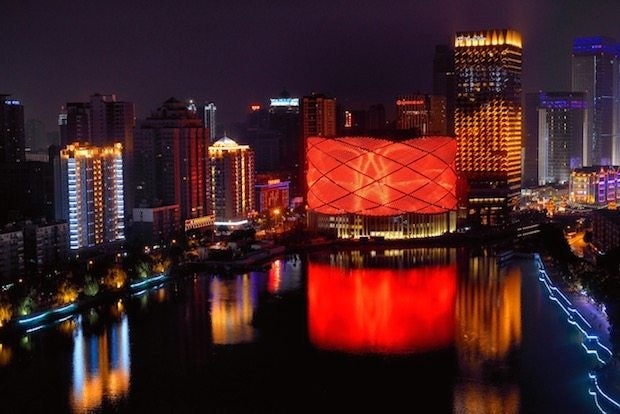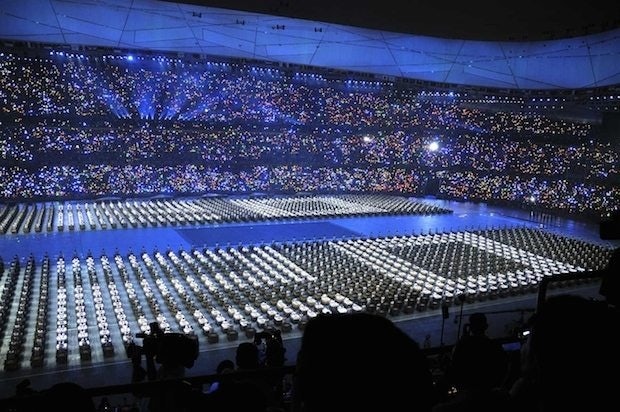
The Han Show Theatre in Wuhan. (Courtesy Photo)
The growth of China’s middle class means skyrocketing demand for leisure activities, and developer Dalian Wanda is rushing to fill it in the country’s lower-tier cities with enormous shopping and entertainment venues. In bustling Wuhan, the company teamed up with UK-based Stufish, an entertainment architecture firm behind the design of the Beijing Olympics opening ceremony stage, to build the Han Show Theatre and Wuhan Movie Theme Park (nicknamed the "Golden Bells" since they it was inspired by the Wuhan Bells artifact) that opened in December in Wuhan’s new Central Cultural District. The Han Show Theatre is set to house an entertainment production created by Franco Dragone, the artistic director behind Cirque du Soleil, while the massive Wuhan Movie Theme Park is touted as the world’s first entirely indoor theme park.
We caught up with Stufish Managing Director Ray Winkler for an interview to learn more about the process behind the development of these projects. In addition to its involvement with the Beijing Olympics, Stufish has designed sets for some of the biggest artists in the global music industry, including Pink Floyd, Rolling Stones, Madonna, Lady Gaga, Tina Turner, and U2. Now, the company has its sights set on China’s lower-tier cities with Wanda’s partnership as Chinese consumers seek out entertainment options.
Can you describe the background of the projects that you just unveiled?
We are a London-based architecture and design company asked by the Dalian Wanda Group and the Franco Dragone entertainment group in about early 2010 to work with Franco Dragone in finding a show for Wanda that would be a trademark Dragone show where Stufish Entertainment Architects was asked to design the building, the interior, as well as the show’s scenic elements and the theatrical special equipment.

The opening ceremony at the 2008 Beijing Olympics. (Courtesy Photo)
How did you become connected with Dalian Wanda?#
I think Stufish’s profile was fairly well-known in China as a result of our involvement with the Beijing Olympics. Mark Fisher, who is the late founder of Stufish, was appointed as the creative director and production designer for the opening ceremony, as a result of which our profile was quite prominent in China and when Franco Dragone was approached by Dalian Wanda Group to design a show for them—one of his trademark water shows—his suggestion that Stufish would be appointed to become the architects for both the building and the show was very well-received because we were at that point quite prolific in China.
What do these new buildings bring to Wuhan that the city might not have had before?#
It’s not just a matter of what the buildings bring to Wuhan; I think it’s a combination of what the building and the building content bring to Wuhan. This touches upon what we at Stufish do and do well: it brings the fusion between architecture and entertainment together. The two buildings, which are for the purpose of the entertainment industry—one of which brings an amazing world-class spectacular in the form of a 90-minute talent show to Wuhan and another brings an indoor movie theme park to Wuhan—will raise the bar of how entertainment is perceived in China. We are very privileged to be the architects that have been involved in the interior and exterior of both these buildings and also are responsible for the TSE (Theatrical Specialist Equipment) within it.
It will bring to Wuhan something very unique—particularly in the case of the Golden Bells, the first indoor theme park with nearly 100,000 square meters of entertainment space and in the case of the Han Show Theatre, the first water show in mainland China and probably the world’s most complicated theatrical show—based on some very, very big machinery that enhances the audience experience.

Stufish Managing Director Ray Winkler. (Courtesy Photo)
What were the inspirations behind the design of the two buildings?#
In the case of the Han Show Theatre, the original idea that launched the conversation of the concept revolved around a modern interpretation of the traditional Chinese red lantern, and in the case of the movie theater, it was a modern interpretation of the very iconic and well-known Wuhan Bells. Both of them have gone through various iterations of interaction with the concept—its past form was never lost, but we were very careful not to fall into the trap of mere pastiche of the traditional shapes.

The Wanda Movie Theme Park in Wuhan is an indoor theme park with an exterior inspired by a famous ancient bell set discovered in Wuhan. (Courtesy Photo)
From your experience in China, how much growth in demand for these kinds of facilities have you seen in China’s smaller cities?#
Given the fact that our client is Wanda—Wanda has specialized in developing second- and third-tier cities—our experience has been primarily seeing the growth in those areas, and the growth is staggering. China’s two major cities and best-known cities—Beijing and Shanghai—I think are absolutely saturated in terms of commercial development and cultural content. Everybody refers to these two cities in ways that probably in the United States people would immediately refer to Los Angeles and New York—as being the prime locations in America for everything.
What I think Wang Jianlin has been absolutely a genius at doing is realizing that the potential in these second- and third-tier cities was there because the critical mass is available in China. Wuhan is a second-tier city the size of London, and that’s something that you must not forget when assessing their decision like building a big theater or a big movie theme park in a second-tier city. Second-tier cities have a different meaning in China. I think because of the Dalian Group’s ambition to go into these places and develop them, they’ve actually managed to create the market suitable for their product.
How much of a rise in demand among the Chinese middle class rise for these kinds of entertainment venues has your company seen?#
We’ve seen them rise from nothing to where it is now. I think five years ago, there wasn’t anything of this scale anywhere in China, and it was through the foresight of the chairman to see there was a market for cultural development. This is tied in directly with the party conference directive that a certain percentage of the Chinese GDP has to be generated out of the creative industries, so an industry was born pretty much overnight.
Like everything in China, the speed at which these things accelerate at is unbelievable. We have seen Wanda build a massive theater, a movie park, and another theater we are about to open in May or June all within the space of four years, which is extraordinary. This is only one out of many developments that have seen a scale in China that we’ve been aware of. The demand of the middle class is clearly there or else these things wouldn’t be built. I think the analogy is taken as “build the roads and the cars will come.”
In the case of theaters, if you give them the product, then the consumer will come and consume. We know that the purchasing power of the middle class is rising steadily, and with a middle class somewhere between 300 to 350 million people—roughly the population of the United States—all looking for entertainment—Wanda hasn’t done bad in tapping into that. Hopefully that success will continue as the middle class and the purchasing power of the middle class grows with it.